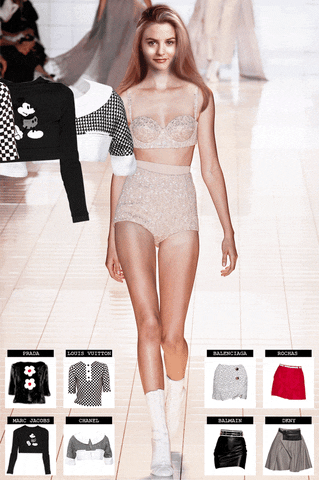
Image via Mann Publications
AR, AI, 3D: THERE’S A LOT GOING ON IN THE FASHION TECH SPACE. BY CLAIRE KALIKMAN.
The fashion system is ripe for innovation. We’ve been operating under the same codes since the 1950s. From the design process to manufacturing, the fashion show to the changing room, there are many steps of the process that can be made more sustainable by the use of technology. Though many of these were in the works well before the pandemic struck, the coronavirus has forced the fashion world to take a deep, hard look at itself and think about how we want the post-pandemic world to look. We investigate the top fashion tech solutions and how they’re making fashion more sustainable.

Image via Clo
3D design What it is: The traditional design process involves the designer sketching out their ideas, making some adjustments after feedback, then producing a prototype. This prototype can go back and forth many, many times, changing fit, colour, fabrication. Design systems like Clo allow users to design everything on their devices and change it as many times as needed. Australian startup 3D Robe also offers 3D prototyping software. How it makes fashion more sustainable: 3D design solutions decrease production of pieces that never see the shop floor and allow greater flexibility to change the garment. 3D designs can even be presented in a digital catalog in place of traditional shoots, saving time and resources.

Image from Helsinki Fashion Week via Fashion United
Digital fashion shows and showrooms What it is: Some fashion shows, including Stockholm and Shanghai, had already experimented with digital fashion weeks even before the pandemic. Now, the coronavirus has accelerated this trend and pushed all fashion weeks and showrooms forward into the digital space. Voor 3D is a “fashtech “startup that provides merchandising showrooms to designer and wholesale brands by using Virtual Reality (VR). Fashion weeks this year in cities including London, Milan, and Paris have also experimented with digital models. Most opted to film presentations or runway shows that tried to recreate the experience of being at a runway show and didn’t dig into the potential digital fashion weeks offer. Helsinki pushed the envelope and transformed its show into the first totally digital fashion show that was a truly innovative step forward. How it makes fashion more sustainable: Buyers, press, and the rest of the fashion cavalcade don’t have to travel from countries around the world, saving loads in carbon emissions. In addition, for fashion weeks such as Helsinki’s, no clothes are actually created for the shows, meaning no waste from garments that are usually not even sold anyway.

Image via Etsy
Made to order /on-demand clothing What it is: On-demand clothing flips the script on the current fashion system. Currently, most brands make a best guess at how much of a certain product consumers will want next season, produce the clothing, then sell the excess at a markdown, or worse, trash or burn it (remember the infamous Burberry incident?) On-demand manufacturing first asks the consumer how much they want, then produces pieces, so there’s no excess waste. So-called micro-factories are popping up that are able to quickly produce clothing with little waste. There’s an added benefit that clothing can become more customized. McKinsey reported that, “We expect rising take-up of on-demand production will lead to a spike in personalization, and a new generation of customized clothing start-ups, creating a new definition of “made to measure.” How it impacts sustainability: Brands fill orders only when they have a customer they know will buy it. This significantly reduces carbon emissions and waste by removing transport of garments that are never sold, packaging materials, fabric leftovers, and unsold merchandise that ends up in landfill. This type of production, which is part of the “slow fashion” model, is a return to the way our grandparents used to shop, when they would go down to a local tailor and have something custom-made for a decent price. Sometimes the best innovations are a return to the old way.

Image of Rebecca Minkoff via Springwise
AR / virtual try-on
What it is: Augmented reality has the potential to change a lot of aspects of the fashion system. L’Oréal pioneered a feature allowing customers to virtually try on makeup products. While fun before, the pandemic has made this feature invaluable while customers can’t use makeup testers at stores. Other brands from Dior to Jacquemus have developed Instagram filters that let users try on sunglasses. The AR innovation that has the most potential to impact sustainability is virtual try-on of clothes. Along with her tech-powered physical changing rooms, Rebecca Minkoff partnered with the app Zeekit to allow customers to try on clothes from anywhere in the world.
How does it impact sustainability: The most impactful aspect of virtual try-on is fewer returns. With customers able to see how they’ll look in clothing before they even order it, they’ll be less inclined to buy pieces that don’t suit them. According to returns technology company Optoro, more than 5 billion items worth around $400 billion are returned every year in the US alone. The company estimates that this generates around 5 billion pounds of waste to landfill and 15 million tons of carbon dioxide. Augmented reality and virtual try-on could change that.

What do you think? Are there any other fashion tech innovations that have changed how you shop?

